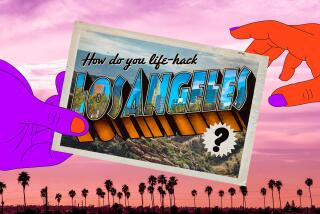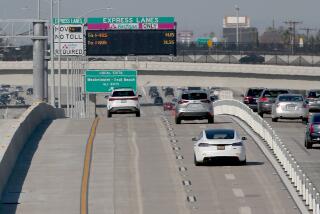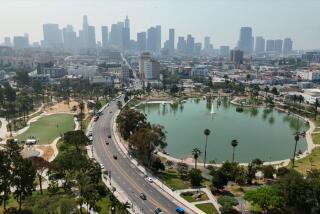Experiment Takes the High Road to Reduce Rush-Hour Gridlock
- Share via
The jumble of metal poles that has suddenly appeared over the old 4th Street bridge east of downtown Los Angeles isn’t a prop for a Fellini movie.
It is an experiment to relieve traffic gridlock.
The city is preparing to test its first fully automated reversible lane--a center lane that would be open in the morning to inbound traffic and in the evening to outbound traffic.
The $1.7-million project is in line with the strategy of traffic engineers to better manage what they have, given the lack of money and environmental and political opposition to road construction.
Transportation officials, for example, have promoted the development of “smart corridors” that use electronic roadway sensors, TV cameras, changeable message signs and other high-tech devices to better identify and respond to traffic problems.
But what’s coming to a one-mile stretch of 4th Street--and eventually other parts of the county, if successful--could prove challenging to even the best road warrior.
As drivers make their way along a street already cluttered with signs, they will see still more messages hanging overhead.
One new sign--controlled by computer from the city’s traffic nerve center in City Hall--will signal when the center lane is open (green arrow), closed (red X) or about to close (yellow arrow).
Another sign will flash no left turn when the reversible lane is in use, which will only be during rush hours.
Additional signs will warn motorists what other lanes they can and cannot use.
“Granted, there will still be some confusion in the beginning,” Kang Hu, a city transportation engineer, admitted.
The city hopes to clear up that confusion by installing more signs along the route to explain the other signs.
But traffic engineers are not worried. The concept works in other cities, they said. They also plan to distribute fliers explaining the signals to motorists before the switch is turned on next month.
For years, workers have been going out every afternoon putting down traffic cones for reversible lanes on Highland Avenue.
Reversible lanes also are used in Inglewood during events at the Forum and on San Francisco’s Golden Gate Bridge.
In San Diego County, the reversible lanes on Interstate 15 are reserved for car-poolers or solo commuters willing to pay a toll.
The system planned on 4th street is so automated that the traffic cones will automatically pop up out of the ground. TV cameras will allow traffic engineers to monitor conditions from City Hall.
Fourth Street was chosen because it is heavily used by commuters as an entry into downtown off the Golden State and Santa Ana freeways.
The reversible lane, extending from the Golden State Freeway almost to Alameda Street, will be open to inbound traffic from 6:30 to 9:30 a.m. and to outbound traffic from 3:30 to 6:30 p.m. weekdays. Left turns will be prohibited during rush hour.
During off-peak periods, the center lane will continue to operate as a left turn and emergency lane for both directions.
Not every street would be a candidate for a reversible lane. They are only effective when there is a pronounced difference in the number of cars moving in each direction.
“It is a very cost-effectve way to reduce congestion,” said Hu.
Transportation reporter Richard Simon can be reached at [email protected]
More to Read
Sign up for Essential California
The most important California stories and recommendations in your inbox every morning.
You may occasionally receive promotional content from the Los Angeles Times.











